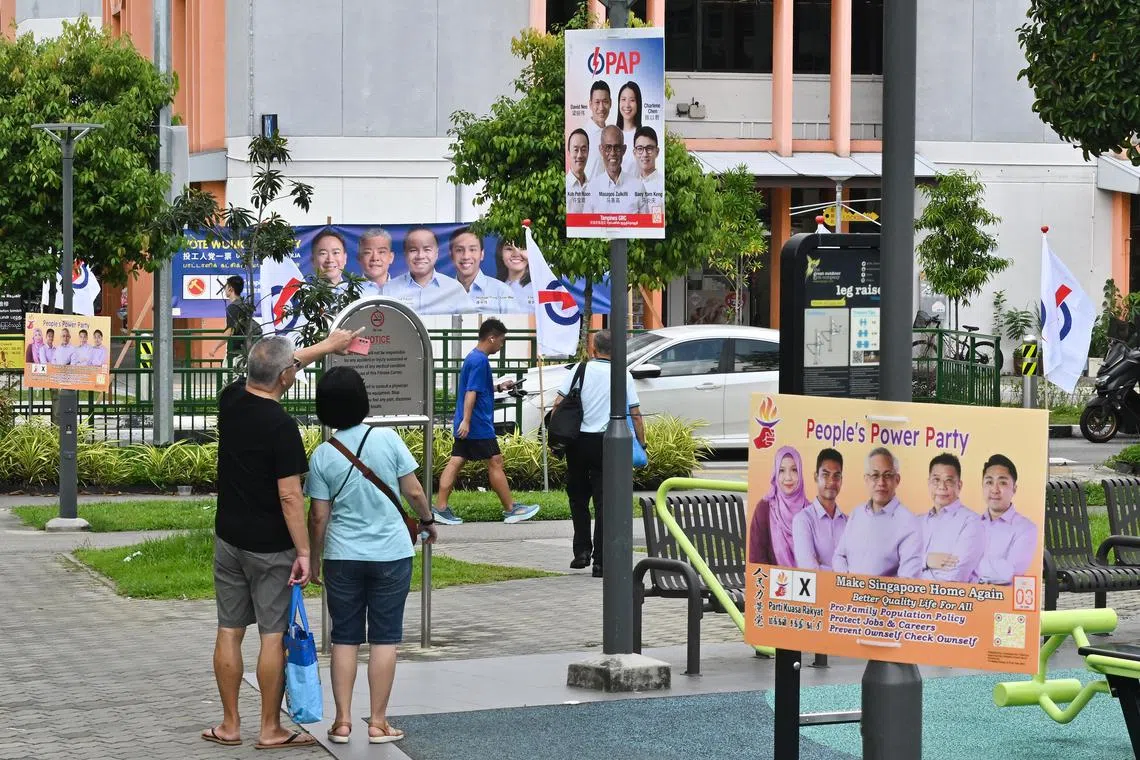Why multi-cornered fights didn’t matter in GE2025
Sign up now: Get ST's newsletters delivered to your inbox

There were five multi-cornered contests in this election, the highest number in decades.
ST PHOTO: LIM YAOHUI
Follow topic:
SINGAPORE - The results of the 2025 General Election
Voters in this election preferred the familiar and the status quo, which meant giving their support to both the PAP and the WP, noted Associate Professor Chong Ja Ian from the National University of Singapore’s department of political science.
“Parties that seemed less familiar saw a sharp drop in support, making multi-cornered fights less important,” he added.
There were five such contests in this election, the highest number in decades. There were just two in the 2020 election and three in 2015.
Multi-cornered fights were “absolutely inconsequential” in this election, said political analyst Tan Ern Ser, adjunct principal research fellow and academic adviser at the Institute of Policy Studies (IPS) Social Lab.
“The fact that the teams sent by the smaller parties paled in comparison to the more established party, like WP, was good enough reason for voters to choose the more viable, credible party,” he added.
In the weeks leading up to the election, several opposition politicians said they wished to avoid multi-cornered fights which would split the opposition vote.
Two new alliances emerged, agreeing to avoid multi-cornered fights among their own members. The People’s Alliance for Reform (PAR) brought the Democratic Progressive Party, the People’s Power Party (PPP), Peoples Voice and the Reform Party under one banner, and an informal “coalition” was formed between the National Solidarity Party (NSP), Red Dot United (RDU), the Singapore People’s Party (SPP) and the Singapore United Party (SUP).
However, the alliances did not preclude multi-cornered fights with other non-member parties, and both also shed members ahead of Nomination Day, with the PPP withdrawing from PAR and RDU withdrawing from the coalition.
At the same time, some opposition party leaders publicly stated they would not move aside for other parties, citing their need to grow and their previous groundwork in certain constituencies.
Previous elections saw various opposition parties coming together for “horse-trading” talks to discuss who would contest where, but such talks fell through this time, with most negotiations taking place bilaterally between the parties.
Just days before Nomination Day, WP secretary-general Pritam Singh told the media
In electoral politics, the phenomenon of a losing candidate who affects the outcome of a multi-cornered electoral contest by splitting the vote is sometimes referred to as a “spoiler effect”.
A third party would be a spoiler in a three-cornered fight if its supporters would have voted for one of the other parties in a straight fight, and the additional votes would have been enough for that party to win.
No spoilers have been observed in a parliamentary election since independence. Historically, the vast majority of such fights resulted in at least one party failing to garner at least 12.5 per cent of the vote and losing their deposits.
These trends continued to hold true in the 2025 election. There were no spoilers across the five constituencies contested by three or more parties, where the PAP won decisively with more than 50 per cent of the vote.
In total, 27 candidates from the NSP, PAR, PPP and SUP collectively forfeited $364,500 in election deposits, all of whom took part in multi-cornered fights.
In Tampines GRC, where the PAP faced the WP as well as teams from the PPP and the NSP, voters seemed to have “abandoned” the latter two parties, leaving them with a negligible level of support, noted Prof Chong.
The five-member group representation constituency ended up being the second-closest fight for the WP, while both the PPP and the NSP garnered below 1 per cent of the vote.
In constituencies not contested by the WP, other parties received more votes but were still “far short of winning”, Prof Chong added.
In Ang Mo Kio GRC, the PPP and the SUP both lost their deposits after garnering a little more than 10 per cent of the vote each in a three-cornered fight against the PAP.
Prof Chong said the creation of the GRC system, which first came into effect in 1988, has made the idea of opposition unity less important as it means parties require both size and resources to be competitive.
“The maturation of the WP into a larger party that could perform well both legislatively and in terms of municipal management meant that it could more easily overwhelm other opposition parties in multi-cornered contests,” he added.
IPS Social Lab’s Dr Tan said the fact that there were more talks about opposition solidarity and the need to avoid multi-cornered fights in the past suggests that the concern about the opposition vote being diluted was more predominant in theory and practice then.
“But the political landscape has changed over the last decade,” he said.
Dr Tan added that Singapore may be gradually shaping up to be, potentially, a two-party system, while Prof Chong said it may evolve into a “1½- or two-party system”.


